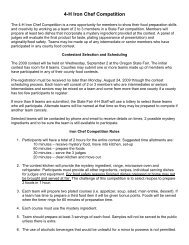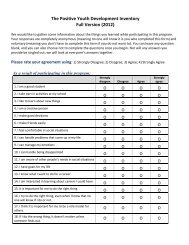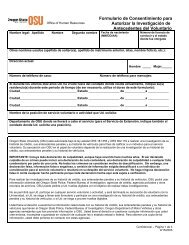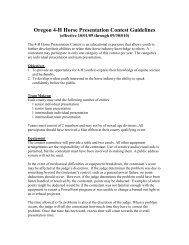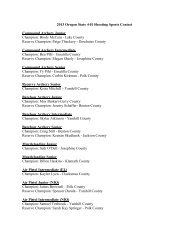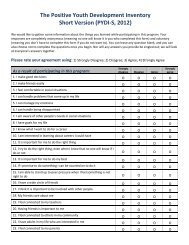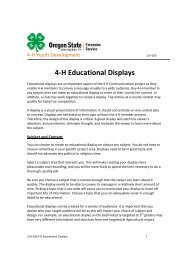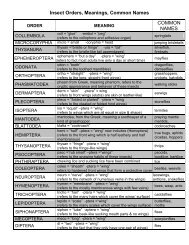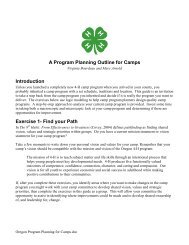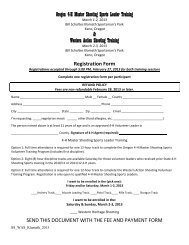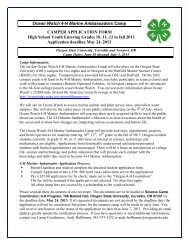Oregon 4-H Shooting Sports Contest Guide 2005 ... - Oregon State 4-H
Oregon 4-H Shooting Sports Contest Guide 2005 ... - Oregon State 4-H
Oregon 4-H Shooting Sports Contest Guide 2005 ... - Oregon State 4-H
Create successful ePaper yourself
Turn your PDF publications into a flip-book with our unique Google optimized e-Paper software.
<strong>Oregon</strong> 4-H<strong>Shooting</strong><strong>Sports</strong> <strong>Contest</strong><strong>Guide</strong>The <strong>Shooting</strong> <strong>Sports</strong> Score Sheets consists of five parts:Part I: To participate in any state or national shooting sports competition, tournament, orcontest, the 4-H participant must complete an assessment of basic knowledge in theirdiscipline(s). This can include but not be limited to safety, mastery, attitude, independence,sportsmanship, generosity, belonging, etc. This will be a 25 point standardized discipline testdeveloped by the state shooting sports training team. (This can be an age modified version ofthe Instructor Discipline Examination.) This test score will follow the 4-H member throughoutthe 4-H year. The 4-H member may retake the test at any time to obtain the maximum 25points.Part II: 4-H participants will be judged on <strong>Sports</strong>manship. Fifty points are possible. Judgesuse their discretion in awarding points based on sound youth development outputs andoutcomes.Part III: 4-H participants will be judged on Range Safety as defined by the specific discipline.Fifty points are possible. Scores are based on the judge’s discretion.Part IV: 4-H participants will be judged on Participant Safety as defined by the specificdiscipline. Twenty-five points are possible. Scores are based on the judge’s discretion.Part V: Parts I through IV equal a sub total of 150 possible points. The maximum disciplinescore, when added to the maximum sub total (Parts I – IV) points, is equal to the total pointspossible for any one class in a shooting sports competition or contest. See the <strong>Shooting</strong><strong>Sports</strong> Score Sheets for each discipline.
This publication has been adapted from the following sources.<strong>2005</strong> 4-H National Match Event Synopsis & General RulesNational 4-H <strong>Shooting</strong> <strong>Sports</strong> Curriculum<strong>Oregon</strong> 4-H Master Rifle Leader <strong>Guide</strong><strong>Oregon</strong> 4-H Archery Mail-in Tournament<strong>Oregon</strong> <strong>State</strong> 4-H <strong>Shooting</strong> <strong>Sports</strong> Training TeamVirginia Bourdeau, 4-H Specialist, <strong>State</strong> CoordinatorAmy Derby, Wheeler County 4-H Youth DevelopmentDaryl Eash, Polk County 4-H VolunteerScott Fairing, Jefferson County 4-H VolunteerJessica Fisher, Umatilla County 4-H Youth DevelopmentTim Kennedy, Deschutes County 4-H VolunteerTim McCormick, Jefferson County 4-H VolunteerMarilyn Moore, Malheur County 4-H Youth DevelopmentMorgan Olson, Union County 4-H Volunteer,Debra Schreiber, Wallowa County 4-H Youth DevelopmentBruce VanderZanden, Deschutes County 4-H VolunteerDavid White, Deschutes County 4-H Youth Development
Objectives of 4-H <strong>Shooting</strong> <strong>Sports</strong>ProgramDr. Ronald A. (Ron) HowardThe 4-H <strong>Shooting</strong> <strong>Sports</strong> Program enhances the abilities of young people, their parents, andadult volunteers to become responsible, self-directed and productive members of society.Agents, leaders, instructors, and coaches understand the goals and objectives of the 4-Hprogram. The program transfers knowledge, skills and attitudes to develop human capital,using the subject matter and resources of the land-grant universities.The specific goals and objectives of the 4-H <strong>Shooting</strong> <strong>Sports</strong> Program include but are notlimited to the following:• Encourage participation in natural resources and related natural sciences programs byexposing participants to the content through shooting, hunting, and related activities.• Enhance development of self-concept, character, and personal growth through safe,educational, and socially acceptable involvement in shooting sports activities.• Teach safe and responsible use of firearms and archery equipment including sounddecision making, self-discipline, and concentration.• Promote the highest levels of safety, sportsmanship and ethical behavior.• Expose participants to a broad array of vocational and avocational activities related toshooting sports.• Strengthen families through participation in life-long recreational activities.• Compliment and enhance the impact of existing safety, shooting, and hunter educationprograms using experiential educational methods and progressive development ofskills and abilities.Remember the differences in the age, experience, abilities and development of youngpeople when programs are presented. Refer to a publication on ages and stages ofdevelopment to be sure appropriate methods are used to reach the objectives.Dr. Ronald A. (Ron) Howard has been a member of the National <strong>Shooting</strong> <strong>Sports</strong>Development Committee since its beginning. During the development of the leader guide hewas Associate Professor of 4-H and Youth and Forestry and Natural Resources at PurdueUniversity. Presently he is a 4-H Specialist, Texas Agricultural Extension Service, Texas 4-HOffice, 809 University Drive East, College Station, Texas 77843-2473
4-H Marksmanship <strong>Contest</strong> <strong>Guide</strong>PurposeMarksmanship contests provide an opportunity for mental and physical growth throughthe integration of sound youth development principles and demonstration of firearmknowledge and proficiency.EligibilityYouth may enter a 4-H marksmanship contest if they are enrolled in a shooting sportsdiscipline 90 days before the contest, have completed the state standardized test, and inaccordance to contest rules.More than one member of the family or club may shoot the same firearm.Junior -Intermediate -Senior -4th, 5th, or 6th grade.7th, 8th, or 9th grade.10th, 11th, or 12th grade.AdvancementAt this time there are no advancements required.General Rules1. Eye Protection: <strong>Shooting</strong> glasses or equivalent prescription glasses are required forall events involving air or powder driven projectiles. They are strongly recommended (but notrequired) for archery events as well. ISU or UIT glasses may be worn only if both eyes areadequately protected. All persons on or near the firing line are required to have eyeprotection, including coaches, range personnel, and shooters.2. Ear Protection: In any event where noise is a recognized hazard to future hearing (i.e.if it goes “bang”) hearing protection is required of all persons on or near the ranges. Ear plugsor head phones may be worn at the discretion of the shooter, range officer or coach; butproper hearing protection is required. Such equipment may be used in air or archery events ifthe shooter desires.3. Open and Empty: All firearms will remain open and empty until the shooter is on therange and the command to “load” or “fire” is given.4. Muzzle Control: Shooters must maintain control of their muzzles at all times.Regardless of condition, muzzles may not be pointed toward or rested upon any part of thebody of the shooter or another person. This includes the use of toe pads in the shotgungames. Violation of this rule may result in warning, disqualification from a round, ordisqualification from a match. 5.5. Semiautomatics: Semiautomatic firearms may be used in most of these events.Shooters using semiautomatic rifles must control their brass to prevent interference withshooters on nearby firing points. Screens, other porous barriers, or shell catchers may beused. Some counties may not allow semiautomatics to be used in competitions.6. Challenges: Scoring of rifle or pistol targets may be reviewed by the shooter only. Heor she may challenge the scoring if they feel it is incorrect for any reason. If the challenge isupheld, the score will be adjusted.
7. Appeals: Shotgun shooters may appeal a ruling on the field immediately if they feel areferee has missed a call. Once the shooter has called for another target, or the next shooterhas fired, such right of appeal is lost. The referee may seek assistance from the scorer ormay poll the squad at his or her discretion. The decision on the field is final and not subject tofurther appeal. Parents or coach’s scoring will not be consulted and is not official.8. Protests: Shooters only may protest any injustice, violation of the rules, or othercircumstance that may have resulted in placing them at a disadvantage relative to othershooters. Such conditions must be reported to the range officer or field referee immediately. Ifsatisfaction is not obtained, the situation should be reported immediately to the eventmanager or chief referee. If resolution is not reached at this point, the shooter only has theright to present a written protest to the chief referee or event manager within 30 minutes ofthe time their squad has finished. The contest advisory committee will investigate and reachfinal resolution of the matter as soon as possible, considering all information.9. Observer Interference: Disruptions by parents, coaches or other individuals will notbe permitted. Sanctions ranging from a warning to ejection from the grounds ordisqualification of an entire team will be imposed for interference with the operation of thematch or disruption of the events on a firing line or field. The unsportsmanship like conductdisplayed by fans will not be tolerated in 4-H <strong>Shooting</strong> <strong>Sports</strong>. Every effort will be made tokeep these events fair, youth centered and positive.10. Coach Removal: The shoot management reserves the right to remove any coachfrom the firing line in the event that his or her behavior is deemed detrimental or distracting totheir own shooters or others. Coaches should remain positive and supportive while beingcareful not to disrupt other shooters. In the event that a coach is removed from the firing line,another coach may substitute for him/her at the discretion of the range officer.11. Alcohol Policy: No alcoholic beverages may be consumed on the grounds of anycounty matches. Violation of this policy is grounds for ejection from the grounds.12. Smoking and Smokeless Tobacco Policy: No smoking or smokeless tobacco ispermitted on or near the firing lines or in any situation where the smoke constitutesinterference to shooters. Smoking and the use of smokeless tobacco, by minors, isprohibited by law, is not permitted in 4-H, and is not permitted on the grounds at any time.13. Dress Code: Participants are expected to dress appropriately. Team uniforms orshirts are encouraged, but not required. Both young people and adults should wear attireappropriate for the weather while remaining modest and socially acceptable. All shooters andcoaches should remember that they may be having photographs taken or be asked tointerview for the media. Remember that you represent all of 4-H <strong>Shooting</strong> <strong>Sports</strong>. Make it apositive image!14. Behavior: All participants and spectators are expected to demonstrate the highestlevel of sportsmanship, supporting the objectives and ideals promoted by the 4-H program ingeneral and the 4-H <strong>Shooting</strong> <strong>Sports</strong> Program in particular. All participants and observersare expected to conform to the Code of Conduct as supplied, not only to the letter, but to theintent.
Firearm SafetyWhen handling a firearm, all safety procedures are practiced. There are three cardinalrules that shall be followed at all times:• Always keep the muzzle or arrow pointed in a safe direction,• Always keep fingers off the trigger or string until ready to shoot,• Always keep the firearm or bow unloaded until ready to use.Many people may question the practice of allowing 4-H youth to handle firearms.However, 4-H shooting sports emphasize positive youth development through safe handling,use, and respect for firearms. 4-H programs educate youth, through an intentional processthat integrates the essential elements of mastery, belonging, independence, and generosity.This integration is proven to be effective in developing behaviors that lead youth to makeinformed decisions about firearms.There are guns in about half of all American homes. 4-H can help adults and childrenenjoy and preserve a Constitutional right if they know how to act around firearms. 4-Hbelieves there is a greater risk to untrained children that may investigate firearms on theirown.With proper education and supervision 4-H shooting sports are safe and integralcomponents of a 4-H program meeting the needs of today’s youth, families, andcommunities.ClothingIn keeping with the member’s budget, dress should conform to the shooting disciplinein which youth are participating in as close as possible. Members should be neat, clean andsafely dressed. Specific clothing requirements and restrictions will be listed under eachdiscipline.Scoring/RibbonsA member must receive a blue ribbon to attend the state contest. Only Intermediateand Senior members are eligible for state contests. See individual <strong>Shooting</strong> <strong>Sports</strong> ScoreSheets for points and awarding of ribbon placements.Rule BooksThe rule books listed in this publication are the recommended rules to use whenholding a competition. The most current version of the listed books will be the rule books usedat the state and national contest.
3-D ROUNDTargets: 3-D targets as selected and placed by the management.Distances: Unmarked distances from 5 to 50 yards.(Sept.2003 rule change)Course of Fire: 30 targets, one arrow per target.Time Limit: Shooters will move through the course expeditiously and avoid delays. Lostarrow search is limited to 2 minutes.Scoring: Fred Bear Scoring will be used: center vital zone, +10(10 or 12 ring); vital zone,+5(8 ring); ethical pass, +1; clean miss, 0; non-vital zone, -5.Maximum of 5 ethical passes permitted. A member must receive a blue ribbon to attend thestate contest. Only Intermediate and Senior members are eligible for state contest. Seeindividual <strong>Shooting</strong> <strong>Sports</strong> Score Sheets for points and awarding of ribbon placements.Rule Book: International Bow hunting Organization (except for scoring).OREGON 4-H MAIL–IN ARCHERY TOURNAMENT (4-H 3611L)General Rules:• Participants must be enrolled in 4-H Archery project.• Participants shoot for score once each month and may enter only one class: BareBow or Freestyle.• Participants should have amble time for practice and warm-up, then should completethe round except for a rest period if needed.• Only target equipment may be used. Archery dealers may purchase Freeman targetswholesale from Martin Archery, Inc., Rt. 5 Box 127, Walla Walla, WA 99362; phone 1-800-541-8902. The other targets used in this tournament are available at most archeryshops. 4-H’ers may make their own targets for practice.• Aiming points (movable markers place on floor) may not be used.• Rounds should be shot during scheduled month and scores submitted on <strong>Oregon</strong> 4-HArchery Mail-in Tournament spreadsheet #3611L to Stanly Miles, 4-H YouthDevelopment Department, Ballard Extension Hall 105, OSU, Corvallis, OR 97331-3608, by the 5th of the following month. Results of top scores (ribbon winners) will besent to participating clubs and Extension 4-H agents each month.Rounds:November ……………….. GoldDecember ……………….. FreemanJanuary ………………….. NFAA IndoorFebruary …………………. NFAA FieldMarch …………………….. Novelty AnimalApril ……………………….. FreemanA complete copy of the rules for the <strong>Oregon</strong> 4-H Mail-in Tournament can be downloaded athttp://eesc.oregonstate.edu or obtained from you local Extension office.
Rifle <strong>Shooting</strong> Position DescriptionSTANDINGSMALL BORE, AIR RIFLE & BB GUNThe Standing Position is the most challenging. It involves fewerpoints of support for the rifle, more muscle activity and less stability than allthe others. Tow basic forms of the standing position differ only in theamount of support for the non-dominant arm. The arm-rest standingposition is used for all types of target shooting. The off-hand or free-armstanding position was formerly used in light rifle shooting.The most commonly used standing position is the arm-rest standing position. Theshooter stand with the feet about shoulder-width apart and the toes at nearly a right angle totthe target. The weight is equally distributed, and the shoulders are in line with the target. Thehead and body are erect. As the rifle is mounted, the body bends back slightly to counter themass of the rifle and keep the center of mass over the spot between the feet. The upper partof the non-dominant arm lies along the rib cage and is supported by it. For shooters who areable to do so, the elbow rests on or inside the flare of the hip.The free-arm standing position or off-hand position is less stable than the armreststanding position. The only difference is the position of the posture of the arm supporting thefore end. The arm-rest position supports the arm with the side of the body. The free-armposition has the arm extended enough for the upper arm to be held away from the body.KNEELINGThe kneeling position adds support and provides greater stability than either of theclassic standing positions. Kneeling positions are used in smallbore position shooting and infield shooting. In the kneeling position the dominate leg is tucked under the body with akneeling roll (optional) tucked under the ankle or foot. Three positions are expectable. Thefoot may be supported by the toes with the heel raised, allowed to lie on its outer side orstretched out with the top surface on the ground or mat (supinated). The shooter may sit onthe foot or hell as long as the buttocks do not touch the mat or ground. The non-dominate legis held with the lower leg vertical as a support for the non-dominant arm.The non-dominate elbow is placed on or over the upright knee, forming a fairly solidbrace for the supporting arm. The head is erect and relaxed. The body inclines forwardslightly, supported on the elbow and knee.SITTINGThe sitting position is more stable than the kneeling position. Two forms are mostcommonly seen, cross-legged or closed sitting positions and open-legged sitting positions.Both forms give excellent shooting results. In four-position rifle shooting, the rules definelegal sitting positions. Field shooters also use the sitting position.The sitting position has an abundant of support for the rifle and provides a stableplatform for accurate shooting. The shooter sits on the ground or the shooting mat, using thelegs as supports for the elbows. Several acceptable styles of sitting position are used.All sitting positions share some common elements. The shooter issitting down, firmly planted on the ground or mat. The body is inclined
forward from the waist, relaxed and resting on the elbows. The head isas erect as possible, leaning forward slightly to avoid strain on the neck.The elbows are braced at the knee.In the extended, open sitting position, the shooter sits nearly square to the target. Theknees are fairly high, and the feet are firmly planted a bit more than shoulder width apart. Theelbows are usually set inside the knees or slightly ahead of the knees. Note that placing thepoint of the elbow on the point of the knee is quite unstable, almost like trying to put two ballsatop each other.In the extended, crossed-ankle sitting position, the shooter sits facing about 30degrees to the dominant side of the target. The legs are extended forward with the anklescrossed. The elbows are placed on the insides of the knees.In the closed sitting position, the shooter sits facing slightly more to the dominant sideof the target, perhaps 45 to 60 degrees. The non-dominant side leg is crossed over thedominant side leg and pulled in rather close to the body. The feet are tucked up under theopposite legs, supporting them with the sides of the foot. As in the other positions, the elbowsrest on the hollows inside the knees.PRONEThe prone position is the most stable of the classic shooting positions. It is used innumerous types of shooting, both on the range and in the field. In the prone position the bodyis supported for almost its entire length on the ground or mat (a mat is recommended,examples: blanket, carpet, sleeping bag, cardboard, shooting mat, etc.) The elbows arebraced on the mat or ground, and the rifle is supported by both elbows and the shoulder. Todevelop a prone position, the shooter lies down on the shooting mat facing slightly to thedominant side of the target. The non-dominant elbow is in front of the shooter. In a positionshooting contest it is required that the shooter’s forearm maintain an angle of 30 degrees ormore from the mat or ground. Most shooters find that flexing the dominant knee slightly givesthem a more stable and comfortable position with less tremor from their heartbeat. Flexing theknee will force the weight to shift slightly to the non-dominant side. The feet may besupported on the tips of the toes, turned in or turned out at the shooter’s discretion. Avoid thetemptation to cross the feet with the legs straight. Doing so tends to invite a narrow, lessstable position and tremors caused by moving the feet. The head should be as erect aspossible without causing muscle strain. The neck should feel relaxed.
SMALLBORE RIFLE MATCHSMALLBORE HUNTING SILHOUETTE RIFLETarget: 1/5 scale metallic silhouettesCourse of Fire: 10 chickens at 40 meters, 10 pigs at 60 meters, 10 turkeys at 77 meters and10 rams at 100 metersTime Limit: 15 second ready time and 2 ½ minutes firing time per bank of 5 targetsEquipment: Any safe small bore rifle chambered for the .22 long rifle, long or short cartridgeand weighing no more than 8 ½ pounds with sights, any sights that do not project an imageon the target or operate the trigger. Firearms must meet stock dimension and otherrequirements in NRA Silhouette Rules 3.1 and 3.2.1.<strong>Shooting</strong> Position: The standard standing position used in position shooting is permitted.Scoring: Targets must be knocked down in order to be scored as hits. Targets not knockeddown or hit out of order will be scored as misses. A member must receive a blue ribbon toattend the state contest. Only Intermediate and Senior members are eligible for state contest.See individual <strong>Shooting</strong> <strong>Sports</strong> Score Sheets for points and awarding of ribbon placements.Rule Book: NRA Rifle Silhouette Rules CS16820EXCEPTION: Factory heavy barrels are permitted in this event in 04 and 05 as long asoverall weight limit is met (because they were accepted at the New Mexico matches). This isan exception from the NRA rules and will be phased out by 2006 National Match. However,no barrels of special composition (carbon) or non-factory styles (i.e. fluted) are permitted.There will be no exceptions to the NRA Rules at the 2006 National Invitational.NRA THREE-POSITION (SPORTER)Target: A-50 (50 meters) or the A-51 (50 yards).Course of Fire: 20 shots in each position – prone, standing and kneeling in that order at 50meters (or 50 yards). 60 record shots.Time Limit: One (1) minute per record shot prone, two (2) minutes per record shot standingand one and one-half (1 ½) minutes per record shot kneeling; maximum time limit of 90minutes, including sighter shots.Equipment: Any Rifle -any safe .22 caliber rim fire rifle chambered for .22 short, .22 Long or.22 long rifle cartridge may be used in small bore 3-position, with a maximum weight or 8.5lbs. No restriction is placed on barrel length or overall weight of rifle and accessories. Slingsmay be used in prone and kneeling.Sights: Metallic sights, non-corrective. Spotting scopes/binoculars are allowed to verify shotplacement for both sighting and record shots fired.Ammunition: Solid point (40 grains) standard velocity – match or target ammunition.Scoring: Each scoring target has a maximum value of 10 points. The tiny dot in the center ofthe target has the value of 10. Shots that remove the dot are center shots or X’s Eachconsecutive scoring band is worth one less point that the one inside it, so the target scores10-9-8-7-6-5-4-3. The ring between the dark bands is part of the higher value scoring area.Any shot touching the ring is given the higher score. Shots that fail to touch any of the scoringarea are given a value of zero. Sometimes a shooter gets confused and fires extra shots atone bull without firing at another one. If the target has only the proper number of record shot,the extra shot is penalized one point and referred to the bull that was not fired upon. If excessshots are taken on the target, the shooter loses the higher value hit on each target with
multiple shots, even if that shot is outside the scoring area. If those excess shots were firedby another shooter (cross-firing), they are not counted against the shooter and are recordedas misses for the person who fired them. If the first sighting shot falls outside the sightingarea and the shooter indicates that id did so, it is not counted as an excess record shot.Scoring gauges and plugs are extremely valuable in determining the exact edge of the bullethole. A member must receive a blue ribbon to attend the state contest. Only Intermediate andSenior members are eligible for state contest. See individual <strong>Shooting</strong> <strong>Sports</strong> Score Sheetsfor points and awarding of ribbon placements.Rule Book: NRA Small bore Rifle Rules CR16750NRA THREE-POSITION MATCH RIFLE This is not a state or national contest.Target: A-36(50 feet).Course of fire: 20 shots in each position – prone, standing and kneeling in that order at 50meters (or 50 yards). 60 record shots.Time limit: One (1) minute per record shot prone, two (2) minutes per record shot standingand one and one-half (1 ½) minutes per record shot kneeling; maximum time limit of 90minutes, including sighter shots.Equipment: Any safe rifle, . 22 caliber rim fire rifle chambered, .22 short, .22 long or .22long rifle cartridge may be used. Slings allowed in prone and kneeling only. No thumb holestocks/butt hooks/palm rest allowed open sights only – no telescopic sights allowed. Norestriction is placed on barrel length or overall weight of rifle and accessories.Sights: Metallic sights, non-corrective, blinders attached to rear sight allowed for nonshootingeye. No scopes allowed on rifle. Spotting scopes/binoculars are allowed to verifyshot placement for both sighting and record shots fired.Ammunition: Solid point (40 grains) standard velocity – match or target ammunition.Scoring: Each scoring target has a maximum value of 10 points. The tiny dot in the center ofthe target has the value of 10. Shots that remove the dot are center shots or X’s. Eachconsecutive scoring band is worth one less point that the one inside it, so the target scores10-9-8-7-6-5-4-3. The ring between the dark bands is part of the higher value scoring area.Any shot touching the ring is given the higher score. Shots that fail to touch any of the scoringarea are given a value of zero. Sometimes a shooter gets confused and fires extra shots atone bull without firing at another one. If the target has only the proper number of record shot,the extra shot is penalized one point and referred to the bull that was not fired upon. If excessshots are taken on the target, the shooter loses the higher value hit on each target withmultiple shots, even if that shot is outside the scoring area. If those excess shots were firedby another shooter (cross-firing), they are not counted against the shooter and are recordedas misses for the person who fired them. If the first sighting shot falls outside the sightingarea and the shooter indicates that id did so, it is not counted as an excess record shot.Scoring gauges and plugs are extremely valuable in determining the exact edge of the bullethole. A member must receive a blue ribbon to attend the state contest. Only Intermediate andSenior members are eligible for state contest See individual <strong>Shooting</strong> <strong>Sports</strong> Score Sheets forpoints and awarding of ribbon placements. Clothing: No restrictions other than clothing mustbe flexible.Rule book: NRA small bore rifle rules
CMP SPORTER RIFLE MATCHTarget: B-19 CMP Rim fire Sporter TargetDistance: 25 yards and 50 yardsCourse of Fire: 60 shots for record50 yards: Prone position-10 shots, Slow fire & 10 shots, rapid fireSitting or Kneeling – 10 shots slow fire & 10 shots rapid fire25 yards: Standing – 10 shots slow fire & 10 shots rapid fireTime Limit: Slow fire- 10 shots in 10 minutes; Rapid fire- 5-shot strings in 25 seconds (semiauto)or 30 seconds for manual repeater.Equipment: Rifle must have a standard Sporter type stock that is constructed of wood orsynthetic material. The overall weight of the rifle, including sights and sling, may not exceed7.5 lbs. Any type of action, semi-automatic or manually operated with a trigger pull of at least3 lbs. Sights: Open sights may be used but receiver sights or a scope not exceeding 6 xmagnifications is permitted. Variable scopes may be used but must be taped andimmobilized at the 6x setting.Scoring: Each scoring target has a maximum value of 10 points. The tiny dot in the center ofthe target has the value of 10. Shots that remove the dot are center shots or X’s. Eachconsecutive scoring band is worth one less point that the one inside it, so the target scores10-9-8-7-6-5-4-3. The ring between the dark bands is part of the higher value scoring area.Any shot touching the ring is given the higher score. Shots that fail to touch any of the scoringarea are given a value of zero. Sometimes a shooter gets confused and fires extra shots atone bull without firing at another one. If the target has only the proper number of record shot,the extra shot is penalized one point and referred to the bull that was not fired upon. If excessshots are taken on the target, the shooter loses the higher value hit on each target withmultiple shots, even if that shot is outside the scoring area. If those excess shots were firedby another shooter (cross-firing), they are not counted against the shooter and are recordedas misses for the person who fired them. If the first sighting shot falls outside the sightingarea and the shooter indicates that id did so, it is not counted as an excess record shot.Scoring gauges and plugs are extremely valuable in determining the exact edge of the bullethole. A member must receive a blue ribbon to attend the state contest. Only Intermediate andSenior members are eligible for state contest. See individual <strong>Shooting</strong> <strong>Sports</strong> Score Sheetsfor points and awarding of ribbon placements.Rule Book: CMP Competition Rules
AIR RIFLE MATCHNATIONAL STANDARD THREE-POSITION SPORTER AIR RIFLETarget: NRA AR 5/10 Distance: 10 meters or 33 feet Course of Fire: 3 x 20. 20 shots eachposition: prone, standing, and kneeling in that order. (60 record shots) Time Limit: 1 1/2minute per record shot prone, 1 1/2 minutes per record shot kneeling, 2 minutes per recordshot standing; with a maximum time of 80 minutes, including sighter shots.Equipment: .177 caliber air rifles under 7.5 pounds with metallic sights are permitted. Triggerpull must be a minimum of 1.5 lbs. Rifles that are officially approved include Daisy753/853/953, Daisy 888, Crossman 2000, and Daisy XSV40. Any rifle not included in this listbut complies with the requirements of the Sporter Air Rifle as stated in the National StandardRules may be submitted to for a decision prior to the competition and may be added to the listof approved rifles. Spotting scopes/binoculars are allowed to verify shot placement for bothsighting and record shots fired.Clothing: Shoes are restricted to soft, low cut, athletic or street shoes that do not extendabove the ankles. Boots are not permitted. A shooting glove may be worn, but no shootingjackets are permitted. Up to two sweatshirts or clothing suitable for the prevailing weather areallowed. A pin or button may be used as a sling keeper in the prone or kneeling positions.Scoring: Each scoring target has a maximum value of 10 points. The tiny dot in the center ofthe target has the value of 10. Shots that remove the dot are center shots or X’s. Eachconsecutive scoring band is worth one less point that the one inside it, so the target scores10-9-8-7-6-5-4-3. The ring between the dark bands is part of the higher value scoring area.Any shot touching the ring is given the higher score. Shots that fail to touch any of the scoringarea are given a value of zero. Sometimes a shooter gets confused and fires extra shots atone bull without firing at another one. If the target has only the proper number of record shot,the extra shot is penalized one point and referred to the bull that was not fired upon. If excessshots are taken on the target, the shooter loses the higher value hit on each target withmultiple shots, even if that shot is outside the scoring area. If those excess shots were firedby another shooter (cross-firing), they are not counted against the shooter and are recordedas misses for the person who fired them. If the first sighting shot falls outside the sightingarea and the shooter indicates that id did so, it is not counted as an excess record shot.Scoring gauges and plugs are extremely valuable in determining the exact edge of the bullethole. A member must receive a blue ribbon to attend the state contest. Only Intermediate andSenior members are eligible for state contest See individual <strong>Shooting</strong> <strong>Sports</strong> Score Sheets forpoints and awarding of ribbon placements.Rule book: CMP (current edition) National Standard Three-position Air Rifle Rules.
NATIONAL STANDARD THREE-POSITION PRECISION AIR RIFLE This is not a state ornational contest.Target: NRA AR 5/10Distance: 10 meters or 33 feet Course of Fire: 3 x 20. 20 shots each position: prone,standing, and kneeling in that order. (60 record shots)Time limit: 1 1/2 minute per record shot prone, 1 1/2 minutes per record shot kneeling, 2minutes per record shot standing; with a maximum time of 80 mintues, including sightershots.Equipment: Any type of 4.5mm (.177 caliber) pneumatic, spring air, compressed air or CO2rifle that conforms to National Standard 3-position air rifle rules. (page 1214) Max weight –12.2 lbs with sights attached precision class equipment changes. Spotting scopes/binocularsallowed to verify shot placement for both sighting & record shots fired. Kneeling rolls areallowed in the kneeling position; shooting kits, shooting stands, shooting mats and blindersare allowed that conform to National Standard 3-position Air Rifle Rules.Sights: Open sights only blinders attached to rear sight allowed for non-shooting eye. Noscopes allowed on rifle. Spotting scopes/binoculars are allowed to verify shot placement forboth sighting and record shots fired.Clothing: <strong>Shooting</strong> jackets, pants, under garments and shoes are allowed that conform toNational Standard 3-position Air Rifle Rules.Scoring: Each scoring target has a maximum value of 10 points. The tiny dot in the center ofthe target has the value of 10. Shots that remove the dot are center shots or X’s. Eachconsecutive scoring band is worth one less point that the one inside it, so the target scores10-9-8-7-6-5-4-3. The ring between the dark bands is part of the higher value scoring area.Any shot touching the ring is given the higher score. Shots that fail to touch any of the scoringarea are given a value of zero. Sometimes a shooter gets confused and fires extra shots atone bull without firing at another one. If the target has only the proper number of record shot,the extra shot is penalized one point and referred to the bull that was not fired upon. If excessshots are taken on the target, the shooter loses the higher value hit on each target withmultiple shots, even if that shot is outside the scoring area. If those excess shots were firedby another shooter (cross-firing), they are not counted against the shooter and are recordedas misses for the person who fired them. If the first sighting shot falls outside the sightingarea and the shooter indicates that id did so, it is not counted as an excess record shot.Scoring gauges and plugs are extremely valuable in determining the exact edge of the bullethole. A member must receive a blue ribbon to attend the state contest. Only Intermediate andSenior members are eligible for state contest See individual <strong>Shooting</strong> <strong>Sports</strong> Score Sheets forpoints and awarding of ribbon placements.Rule book: CMP (current edition) National Standard Three-position Air Rifle RulesSPORTER AIR RIFLE EVENT (STANDING)Target: NRA AR 5/10Distance: 10 meters or 33 feet. Course of Fire: 40 shots standing.Time Limit: 2 minutes per record shot standing; maximum time of 80 minutes, includingsighter shots.Equipment: .177 caliber air rifles under 7.5 pounds with metallic sights are permitted. Triggerpull must be a minimum of 1.5 lbs. Rifles that are officially approved include Daisy753/853/953, Daisy 888, Crossman 2000, and Daisy XSV40. Any rifle not included in this listbut complies with the requirements of the Sporter Air Rifle as stated in the National StandardRules may be submitted to for a decision prior to the competition and may be added to the list
of approved rifles. Spotting scopes/binoculars are allowed to verify shot placement for bothsighting and record shots fired.Clothing: Shoes are restricted to soft, low cut, athletic or street shoes that do not extendabove the ankles. No boots are permitted. A shooting glove may be worn, but no shootingjackets are permitted. Up to two sweatshirts or clothing suitable for prevailing weather areallowed. Spotting scopes/binoculars allowed to verify shot placement for both sighting &record shots fired.Scoring: Each scoring target has a maximum value of 10 points. The tiny dot in the center ofthe target has the value of 10. Shots that remove the dot are center shots or X’s. Eachconsecutive scoring band is worth one less point that the one inside it, so the target scores10-9-8-7-6-5-4-3. The ring between the dark bands is part of the higher value scoring area.Any shot touching the ring is given the higher score. Shots that fail to touch any of the scoringarea are given a value of zero. Sometimes a shooter gets confused and fires extra shots atone bull without firing at another one. If the target has only the proper number of record shot,the extra shot is penalized one point and referred to the bull that was not fired upon. If excessshots are taken on the target, the shooter loses the higher value hit on each target withmultiple shots, even if that shot is outside the scoring area. If those excess shots were firedby another shooter (cross-firing), they are not counted against the shooter and are recordedas misses for the person who fired them. If the first sighting shot falls outside the sightingarea and the shooter indicates that id did so, it is not counted as an excess record shot.Scoring gauges and plugs are extremely valuable in determining the exact edge of the bullethole. Scores A member must receive a blue ribbon to attend the state contest. OnlyIntermediate and Senior members are eligible for state contest. See individual <strong>Shooting</strong><strong>Sports</strong> Score Sheets for points and awarding of ribbon placements.Rule Book: CMP (current edition) National Standard Three-position Air Rifle Rules – exceptcourse of fire as noted above.PRECISION AIR RIFLE (STANDING) This is not a state or national contest.Target: NRA AR 5/10Distance: 10 meters or 33 feet.Course of Fire: 40 shots standing.Time limit: 2 minutes per record shot standing; maximum time of 80 minutes, includingsighter shots.Equipment: Any type of 4.5mm(.177 caliber) pneumatic, spring air, compressed air or CO2rifle that conforms to National Standard 3-Position Air Rifle Rules (page 1214). Max weight –12.2 lbs with sights attached. Spotting scopes/binoculars allowed to verify shot placement forboth sighting and record shots fired. <strong>Shooting</strong> kits, shooting stands and blinders are allowedthat conform to National Standard 3Position Air Rifle Rules.Sights: Open sights only, blinders attached to rear sight allowed for non-shooting eye. Noscopes allowed on rifle. Spotting scopes/binoculars are allowed to verify shot placement forboth sighting and record shots fired.Clothing: <strong>Shooting</strong> jackets, pants, under garments and shoes are allowed that conform toNational Standard 3-Position Air Rifle Rules.Scoring: Each scoring target has a maximum value of 10 points. The tiny dot in the center ofthe target has the value of 10. Shots that remove the dot are center shots or X’s Eachconsecutive scoring band is worth one less point that the one inside it, so the target scores10-9-8-7-6-5-4-3. The ring between the dark bands is part of the higher value scoring area.Any shot touching the ring is given the higher score. Shots that fail to touch any of the scoring
area are given a value of zero. Sometimes a shooter gets confused and fires extra shots atone bull without firing at another one. If the target has only the proper number of record shot,the extra shot is penalized one point and referred to the bull that was not fired upon. If excessshots are taken on the target, the shooter loses the higher value hit on each target withmultiple shots, even if that shot is outside the scoring area. If those excess shots were firedby another shooter (cross-firing), they are not counted against the shooter and are recordedas misses for the person who fired them. If the first sighting shot falls outside the sightingarea and the shooter indicates that id did so, it is not counted as an excess record shot.Scoring gauges and plugs are extremely valuable in determining the exact edge of the bullethole. A member must receive a blue ribbon to attend the state contest. Only Intermediate andSenior members are eligible for state contest. See individual <strong>Shooting</strong> <strong>Sports</strong> Score Sheetsfor points and awarding of ribbon placements.Rule Book: CMP (current edition) National Standard Three-position Air Rifle Rules – exceptcourse of fire as noted above.SPORTER AIR RIFLE SILHOUETTETarget: 1/10 scale metallic silhouettes.Course of Fire: 10 chickens at 20 yards, 10 pigs at 30 yards, 10 turkeys at 36 yards, 10 ramsat 45 yards in banks of 5 targets and shooting from left to right on each bank of targets.Time Limit: 15 second ready time and 2 ½ minutes firing time for each bank of 5 targets.Equipment: Any unaltered factory Sporter air rifle that is or was a catalogue item, readilyavailable over the counter to the general public, weighing no more than 11 pounds, withscope and mounts. Rifles utilizing pre-charged systems of any kind other than 12.0 gramdisposable CO2 units are prohibited. (NRA 3.3b) –SEE EXCEPTION below.<strong>Shooting</strong> Position: The standard standing position used in position shooting is permitted.Scoring: Targets knocked down or off the stand in order are scored as hits, others score asmisses. A member must receive a blue ribbon to attend the state contest. Only Intermediateand Senior members are eligible for state contest. See individual <strong>Shooting</strong> <strong>Sports</strong> ScoreSheets for points and awarding of ribbon placements.Rule book: NRA Rifle Silhouette Rules CS16820
NRA FOUR-POSITION BB GUN This is not a state or national contest.Targets: AR-4/10(12 bulls eye) targets manufactured after 04.01.05Course of fire:Prone position 10 shots 10 minutes for sighting & record shotsStanding position 10 shots 10 minutes for sighting & record shotsSitting position 10 shots 10 minutes for sighting & record shotsKneeling position 10 shots 10 minutes for sighting & record shotsTime limit: 10 minutes for sighting and record shots, including any sighter shots.Equipment: Any shoulder held smoothbore BB gun w/ metallic sights, in which the propellingforce is developed through the use of compressed spring, gas or compressed air. Noalterations made be made to BB guns except to the stock to adjust Overall length. No otheralterations are allowed!!! Weight may be added in fore end & stock only. No weights may beadded to the interior or exterior of the barrel. Slings are allowed in prone, sitting & kneelingpositions. Maximum width is 1.25” wide. A single kneeling roll is allowed. It must be soft andflexible. Hooked butt plates or thumbhole prohibited maximum weight is 6 pounds with sights.Sights: factory installed sights or upgrade to daisy front/rear aperture sights only. Blindersattached to rear sight allowed for non-shooting eye. No scopes allowed on rifle. Spottingscopes/binoculars are allowed to verify shot placement for both sighting and record shotsfired. Ammunition: Only round .177(4.5mm) lead or steel BB’s are permitted. Steel ballbearings are prohibited.Scoring: Same as NRA 3-position small bore Maximum score 400 points. A member mustreceive a blue ribbon to attend the state contest. Only Intermediate and Senior members areeligible for state contest. See individual <strong>Shooting</strong> <strong>Sports</strong> Score Sheets for points andawarding of ribbon placements.Clothing: Ordinary sports or casual clothing, suitable for prevailing weather, must be worn.No padded shooting jackets, vest or pants, unusually heavy clothing, gloves, footwear higherthan the ankle are permitted. No pads, braces, or elastic bandages will be allowed w/oapproval of the match director(s).Rule book: NRA BB Gun Rules.SMALLBORE PISTOL MATCH EVENTSNote: All pistol shooters under the age of 18 must have in their possession a writtenpermission statement from their parent or guardian stating their permission to possess andfire pistols to be in compliance with Bureau of Alcohol, Tobacco, Firearms and Explosivesregulations. We suggest a simple statement, shrunken to card size with the name of theshooter, and the parent’s name and address as well as their signature and that of a witnessand dates. Some shooters use this in a laminated form, keeping it with the shooting kit. Allmatches are “single pistol” matches. A shooter is to shoot the entire course of fire of thatevent with the same pistol. No pistol changes between stages.
CAMP PERRY ROUND (modified)Target: NRA B-8 Distance: 25 yards Course of Fire: 10 shots each slow fire, 15-timed fireand 15rapid fire. (40 record shots)Time Limits:Slow fire: 5 minutes (10 shot string)Timed fire: 20 seconds per 5 shot stringRapid fire: 10 seconds per 5 shot string<strong>Shooting</strong> Positions: One-handed standingScoring: Each scoring target has a maximum value of 10 points. The tiny dot in the center ofthe target has the value of 10. Shots that remove the dot are center shots or X’s Eachconsecutive scoring band is worth one less point that the one inside it, so the target scores10-9-8-7-6-5-4-3. The ring between the dark bands is part of the higher value scoring area.Any shot touching the ring is given the higher score. Shots that fail to touch any of the scoringarea are given a value of zero. Sometimes a shooter gets confused and fires extra shots atone bull without firing at another one. If the target has only the proper number of record shot,the extra shot is penalized one point and referred to the bull that was not fired upon. If excessshots are taken on the target, the shooter loses the higher value hit on each target withmultiple shots, even if that shot is outside the scoring area. If those excess shots were firedby another shooter (cross-firing), they are not counted against the shooter and are recordedas misses for the person who fired them. If the first sighting shot falls outside the sightingarea and the shooter indicates that it did so, it is not counted as an excess record shot.Scoring gauges and plugs are extremely valuable in determining the exact edge of the bullethole. A member must receive a blue ribbon to attend the state contest. Only Intermediate andSenior members are eligible for state contest. See individual <strong>Shooting</strong> <strong>Sports</strong> Score Sheetsfor points and awarding of ribbon placements.Equipment: Iron sights only. Any small bore pistol or revolver firing the .22 rim fire long rifle,long or short cartridge with a sight radius no greater than 10 inches, and a trigger pull no lessthan 2 pounds. (Rule 3.4-except iron sights only.)Rule book: NRA Pistol Rules CP16650.SLOW-FIRE BULLSEYE – single stageTarget: NRA B-8Distance: 25 yardsCourse of Fire: All slow-fire, 40 record shots at 25 yards Time Limit: 10 shots per 10 minutestring.<strong>Shooting</strong> Position: One hand standing.Scoring: Each scoring target has a maximum value of 10 points. The tiny dot in the center ofthe target has the value of 10. Shots that remove the dot are center shots or X’s. Eachconsecutive scoring band is worth one less point that the one inside it, so the target scores10-9-8-7-6-54-3. The ring between the dark bands is part of the higher value scoring area.Any shot touching the ring is given the higher score. Shots that fail to touch any of the scoringarea are given a value of zero. Sometimes a shooter gets confused and fires extra shots atone bull without firing at another one. If the target has only the proper number of record shot,the extra shot is penalized one point and referred to the bull that was not fired upon. If excessshots are taken on the target, the shooter loses the higher value hit on each target withmultiple shots, even if that shot is outside the scoring area. If those excess shots were firedby another shooter (cross-firing), they are not counted against the shooter and are recorded
as misses for the person who fired them. If the first sighting shot falls outside the sightingarea and the shooter indicates that it did so, it is not counted as an excess record shot.Scoring gauges and plugs are extremely valuable in determining the exact edge of the bullethole. A member must receive a blue ribbon to attend the state contest. Only Intermediate andSenior members are eligible for state contest. See individual <strong>Shooting</strong> <strong>Sports</strong> Score Sheetsfor points and awarding of ribbon placements.Equipment: Any small bore pistol or revolver firing the .22 rim fire long rifle, long or shortcartridge with a sight radius no greater than 10 inches, equipped with any sights that do notproject an image onto the target and a trigger pull no less than 2 pounds. (Rule 3.4, anysights.)Rule book: NRA Pistol Rules CP16650.SMALLBORE HUNTER’S PISTOL SILHOUETTETarget: ½ scale metallic silhouettesCourse of Fire: All shooting in banks of 5 targets, shooting from left to right.10 chickens at 40 meters, 10 pigs at 50 meters, 10 turkeys at 75 meters, 10 rams at 100meters. 40 record shots.Time Limit: 30 second ready time and 2 minute firing time for each bank of 5 targets.Equipment: Any factory available small bore pistol weighing no more than 5.0 pounds,chambered for the .22 rim fire long rifle cartridge and having a factory standard barrel lengthof no more than 12 inches measured from breech face to muzzle (NRA rule change 2004)equipped with any sights that do not project an image on the target and a safe trigger. (NRAPistol Silhouette Rule 3.1 and 3.2)<strong>Shooting</strong> Position: Only standing positions may be used, two-hand holds permitted but thehands and arms must be fee of the body and may not touch beyond the wrist (NRA Rule 5.8)Scoring: Targets knocked down in order are scored as hits, those not knocked down or shotout of order are scored as misses. A member must receive a blue ribbon to attend the statecontest. Only Intermediate and Senior members are eligible for state contest. See individual<strong>Shooting</strong> <strong>Sports</strong> Score Sheets for points and awarding of ribbon placements.Rule book: NRA Pistol Silhouette Rules CS16830AIR PISTOL MATCHSLOW FIRE -BULLSEYETarget: NRA B-40 or B-40/4Distance: 10 meters or 33 feet.Course of Fire: 40 shots, 10 shot strings, 5 shots per bull.Time Limit: 1½ minute per record shot (15 minutes per string) 10 min preparation time, 15min for unlimited sighting shots.<strong>Shooting</strong> Position: One-handed hold, standing.Equipment: Any .177 caliber (4.5 mm) air pistol weighing less than 3.3 pounds with a triggerpull of at least 17.6 ounces, metallic sights only. Pellets must be single loaded.Scoring: Each scoring target has a maximum value of 10 points. The tiny dot in the center ofthe target has the value of 10. Shots that remove the dot are center shots or X’s. Eachconsecutive scoring band is worth one less point that the one inside it, so the target scores10-9-8-7-6-5-4-3. The ring between the dark bands is part of the higher value scoring area.Any shot touching the ring is given the higher score. Shots that fail to touch any of the scoring
area are given a value of zero. Sometimes a shooter gets confused and fires extra shots atone bull without firing at another one. If the target has only the proper number of record shot,the extra shot is penalized one point and referred to the bull that was not fired upon. If excessshots are taken on the target, the shooter loses the higher value hit on each target withmultiple shots, even if that shot is outside the scoring area. If those excess shots were firedby another shooter (cross-firing), they are not counted against the shooter and are recordedas misses for the person who fired them. If the first sighting shot falls outside the sightingarea and the shooter indicates that id did so, it is not counted as an excess record shot.Scoring gauges and plugs are extremely valuable in determining the exact edge of the bullethole. A member must receive a blue ribbon to attend the state contest. Only Intermediate andSenior members are eligible for state contest. See individual <strong>Shooting</strong> <strong>Sports</strong> Score Sheetsfor points and awarding of ribbon placements.Rule book: NRA International Style Pistol Rules CI16500.TIMED FIRE/RAPID FIRE COMBOTarget: NRA B-40 or B-40/4Distance: 10 meters or 33 feet.Course of Fire: Total of 40 record shots.Timed Fire: 20 record shots, 4 strings of 5 shots, 5 per bull.(pellets must be single loaded). Followed by -Rapid Fire: 20 record shots, 4 strings of 5 shotsTimed Fire: on command, 5 seconds per shot. Time will be provided to safely load pistolsbetween shots. Time of 5 seconds is between Commence fire and Cease fire.Rapid Fire: 10 seconds per string of 5 shots.<strong>Shooting</strong> Position: One-handed hold standing.Scoring: Each scoring target has a maximum value of 10 points. The tiny dot in the center ofthe target has the value of 10. Shots that remove the dot are center shots or X’s. Eachconsecutive scoring band is worth one less point that the one inside it, so the target scores10-9-8-7-6-5-4-3. The ring between the dark bands is part of the higher value scoring area.Any shot touching the ring is given the higher score. Shots that fail to touch any of the scoringarea are given a value of zero. Sometimes a shooter gets confused and fires extra shots atone bull without firing at another one. If the target has only the proper number of record shot,the extra shot is penalized one point and referred to the bull that was not fired upon. If excessshots are taken on the target, the shooter loses the higher value hit on each target withmultiple shots, even if that shot is outside the scoring area. If those excess shots were firedby another shooter (cross-firing), they are not counted against the shooter and are recordedas misses for the person who fired them. If the first sighting shot falls outside the sightingarea and the shooter indicates that id did so, it is not counted as an excess record shot.Scoring gauges and plugs are extremely valuable in determining the exact edge of the bullethole. A member must receive a blue ribbon to attend the state contest. Only Intermediate andSenior members are eligible for state contest. See individual <strong>Shooting</strong> <strong>Sports</strong> Score Sheetsfor points and awarding of ribbon placements.Equipment: any .177 caliber (4.5mm) air pistol weighing less than 3.3 pounds with a triggerpull of at least 17.6 ounces, metallic sights only.Rule book: NRA International Style Pistol Rules CI16500.
AIR PISTOL SILHOUETTETarget: 1/10 scale metallic silhouettesCourse of Fire: 10 chickens at 10 yards, 10 pigs at 12.5 yards, 10 turkeys at 15Rule Book: National Skeet <strong>Shooting</strong> Association yards, 10 rams at 18 yards in banks of 5targets and shooting from left to right on each bank of targets. Time Limit: 30 seconds readytime and 2 minute firing time for each bank of 5 targets.Equipment: Any air pistol caliber .22 or smaller equipped with any sights that do not projectan image on the target and having a safe trigger.<strong>Shooting</strong> Position: Only standing positions may be used, two-hand holds permitted but thehands and arms must be free of the body and may not touch beyond the wrists (NRA Rule5.8).Scoring: Targets knocked down in order are scored as hits, those not knocked down or shotout of order are scored as misses. A member must receive a blue ribbon to attend the statecontest. Only Intermediate and Senior members are eligible for state contest. See individual<strong>Shooting</strong> <strong>Sports</strong> Score Sheets for points and awarding of ribbon placements.Rule book: NRA Pistol Silhouette Rules CS16830.SHOTGUN EVENTS Release triggers are not permitted.TRAPEvent: Standard ATA (American) trap (16 yards).Course of Fire: 4 rounds (100 targets) consisting of five targets from each of five shootingstations at 16 yards. Seniors may shoot 8 rounds (200 targets) consisting of five targets fromeach of the five shooting stations at 16 yards.Shoot-offs: Five targets from stations 1 and 5 from the 21 yard line. Management mayincrease the distance to 27 yards if required to break ties.Time Limit: Shooters will fire in an expeditious manner, avoiding unnecessary delay andshould be prepared to take the field up to 1 hour prior to listed start time.Equipment: Any shotgun 12 gauge or smaller firing a shot charge not to exceed 1 1/8 ounceswith shot no larger than US 7 ½ fine or smaller than US 9 fine at velocities approximately1200 feet per second.Scoring: A member must receive a blue ribbon to attend the state contest. Only Intermediateand Senior members are eligible for state contest. See individual <strong>Shooting</strong> <strong>Sports</strong> ScoreSheets for points and awarding of ribbon placements.Rule Book: American Trap Association.Equipment: Any shotgun 12 gauge or smaller firing a shot charge not to exceed 1 1/8ounces with shot no larger than US 7 ½ fine or smaller than US 9 fine at velocitiesapproximately 1200 feet per second.Rule Book: There is no rule book for these events.
HUNTING SKILLS EVENTSAll hunting events will be based on the content of the 4-H <strong>Shooting</strong> <strong>Sports</strong> Hunting <strong>Guide</strong>,NRA Hunters <strong>Guide</strong> and wildlife guides from Federal and the <strong>Oregon</strong> Hunter EducationManual. Unless otherwise stated, all required equipment and materials will be provided. Allevents will be individual events with team scores.NOTE: Not every discipline listed is guaranteed to be at the <strong>State</strong> Competition. This is a draftat this time.SAFETY TRAILEvent Description: Hunter’s safety trail with shoot/no shoot situations. <strong>Contest</strong>ants will oralor written reasons why a shot could or should not be taken.Course: 20 decision-making stations based on the content of the Hunting<strong>Guide</strong>.Time Length: maximum 2 minutes per station.Scoring: 50 points per station. A member must receive a blue ribbon to attend the statecontest. Only Intermediate and Senior members are eligible for state contest.BLOOD TRAILEvent Description: Follow an artificial blood trail with a simulated big game animal at theend. Trail may be refreshed as needed.Course: Approximately 100 yard trail.Time Length: maximum 20 minutes.Scoring: 500 point each for correctly identifying the type of blood, finding hair or intestinalmatter and 500 points for finding the animal. A member must receive a blue ribbon to attendthe state contest. Only Intermediate and Senior members are eligible for state contest. Seeindividual <strong>Shooting</strong> <strong>Sports</strong> Score Sheets for points and awarding of ribbon placements.WILDLIFE ID—HABITS & HABITATEvent Description: Identify samples of fur, scat, tracks, skulls, pictures, horns, antlers andbird wings. Answer questions concerning the habits and habitat of each animal.Course: 20 animals.Time Length: maximum 5 minutes per animal.Scoring: 10 points each part to equal 50 points per animal. A member must receive a blueribbon to attend the state contest. Only Intermediate and Senior members are eligible forstate contest. See individual <strong>Shooting</strong> <strong>Sports</strong> Score Sheets for points and awarding of ribbonplacements.
MAP READINGEvent Description: Plot a course using a USGS map and compass. Determine a distancefrom a given point to a landmark on the map.Course: Two map problems.Time Length: maximum 10 minutes each.Scoring: 500 points per problem. A member must receive a blue ribbon to attend the statecontest. Only Intermediate and Senior members are eligible for state contest. See individual<strong>Shooting</strong> <strong>Sports</strong> Score Sheets for points and awarding of ribbon placements.ORIENTEERINGEvent Description: Complete an orienteering course.Course: Two courses.Time Length: 20 minutes each.Scoring: 500 points each, five point deduction for every foot from course end. A membermust receive a blue ribbon to attend the state contest. Only Intermediate and Seniormembers are eligible for state contest. See individual <strong>Shooting</strong> <strong>Sports</strong> Score Sheets forpoints and awarding of ribbon placements.BASIC GPSEvent Description: Complete a GPS course from start through 19 waypoint(s) and backtrackto starting point.Course: 200 yard course navigating around obstacles.Time Length: 20 minutes.Scoring: 50 points each waypoint and the end point. A member must receive a blue ribbonto attend the state contest. Only Intermediate and Senior members are eligible for statecontest. See individual <strong>Shooting</strong> <strong>Sports</strong> Score Sheets for points and awarding of ribbonplacements.ESTIMATING DISTANCESEvent Description: Estimate random target distance from 50 to 400 yards. <strong>Contest</strong>ant willview, estimate and record distances.Course: 10 targets.Time Length: 2 minutes each.Scoring: 100 points each, one point deducted for each yard missed to a maximum of 50points per target. A member must receive a blue ribbon to attend the state contest. OnlyIntermediate and Senior members are eligible for state contest. See individual <strong>Shooting</strong><strong>Sports</strong> Score Sheets for points and awarding of ribbon placements.
FIREARM HUNTINGEvent Description: Written and/or oral testing covering knowledge of firearm safety,handling, nomenclature, and hunting practices. Rifles, handguns and muzzleloader andammunition will be covered.Course: 50 questions.Time Length: 1 hour.Scoring: 20 points per question. A member must receive a blue ribbon to attend the statecontest. Only Intermediate and Senior members are eligible for state contest. See individual<strong>Shooting</strong> <strong>Sports</strong> Score Sheets for points and awarding of ribbon placements.SHOTGUN HUNTINGEvent Description: Written and/or oral testing covering knowledge of shotgunsafety, handling, nomenclature, and hunting practices and ammunition.Course: 50 questions.Time Length: 1 hour.Scoring: 20 points per question. A member must receive a blue ribbon to attend the statecontest. Only Intermediate and Senior members are eligible for state contest. See individual<strong>Shooting</strong> <strong>Sports</strong> Score Sheets for points and awarding of ribbon placements.BOW HUNTINGEvent Description: Written and/or oral testing covering knowledge of bow hunting safety,handling, nomenclature, and hunting practices. Long bow, recurve, compound and crossbows and arrows.Course: 50 questions.Time Length: 1 hour.Scoring: 20 points per question. A member must receive a blue ribbon to attend the statecontest. Only Intermediate and Senior members are eligible for state contest. See individual<strong>Shooting</strong> <strong>Sports</strong> Score Sheets for points and awarding of ribbon placements.GAME CAREEvent Description: Written and/or oral testing covering knowledge of field dressing andgame care.Course: 50 questions.Time Length: 1 hour.Scoring: 20 points per question. A member must receive a blue ribbon to attend the statecontest. Only Intermediate and Senior members are eligible for state contest. See individual<strong>Shooting</strong> <strong>Sports</strong> Score Sheets for points and awarding of ribbon placements.
REFERENCESARCHERY FITA ROUND (1/2 FITA) Rule book: USA Archery/FITA Can be downloaded at(Book 2, 94 pages; Book 3, 82 pages)http://www.archery.org/rulebook/rule2004/rule2004.htmlFIELD ROUND (1/2 Field Round) Rule book: National Field Archery Association Can bedownloaded at (7 pages) http://www.nfaa-archery.org/field/styles.cfm3-D ROUND Rule book: International Bowhunters Organization (except for scoring)Can be downloaded at (20 pages) http://www.ibo.net/rules/SMALLBORE RIFLE SMALLBORE HUNTING SILHOUETTE RIFLE Rule Book: NRA RifleSilhouette Rules CS16820 (January 2003) Can be purchase online for $2.50 athttp://materials.nrahq.org/go/products.aspx?cat=RulebooksNRA THREE-POSITION (Sporter and Precision) Rule Book: NRA Smallbore Rifle RulesCR16750 (Rev June 1, 2003) Can be purchase online for $2.50 athttp://materials.nrahq.org/go/products.aspx?cat=RulebooksCMP SPORTER RIFLE MATCH Rule Book: CMP Competition Rules – current edition Canbe downloaded at (64 pages) http://www.odcmp.com/Competitions/Rulebook.pdfCivilian Marksmanship Program US Postal Service: PO Box 576 Port Clinton, OH 43452UPS or Fed Ex: Camp Perry Training Site Building 3 Port Clinton, OH 43452 Telephone:(419) 635-2141 Fax: (419) 635-2802 Program Fax (419) 635-2573 E-mail:custserve@odcmp.comAIR RIFLE NATIONAL STD THREE-POSITION AIR RIFLE (Sporter and Precision) Rulebook: CMP 2002-2004 National Standard Three-position Air Rifle Rules Can be downloadedat (114 pages) http://www.odcmp.com/3P/Rules.pdfSPORTER AIR RIFLE EVENT (STANDING - Sporter and Precision) Rule Book: CMP2002-2004 National Standard Three-position Air Rifle Rules Can be downloaded at (114pages) http://www.odcmp.com/3P/Rules.pdfSPORTER AIR RIFLE SILHOUETTE Rule book: NRA Rifle Silhouette Rules CS16820 (RevJan 2003) Can be purchase online for $2.50 athttp://materials.nrahq.org/go/products.aspx?cat=RulebooksSMALLBORE PISTOL CAMP PERRY ROUND (modified) Rule book: NRA Pistol RulesCP16650 (2003)Can be purchase online for $2.50 athttp://materials.nrahq.org/go/products.aspx?cat=RulebooksSLOW-FIRE BULLSEYE – single stage Rule book: NRA Pistol Rules CP16650 (2003) Canbe purchase online for $2.50 at http://materials.nrahq.org/go/products.aspx?cat=Rulebooks
SMALLBORE HUNTER’S PISTOL SILHOUETTE Rule book: NRA Pistol Silhouette RulesCS16830 (rev April 1, 2002) Can be purchase online for $2.50 athttp://materials.nrahq.org/go/products.aspx?cat=RulebooksAIR PISTOL SLOW FIRE -BULLSEYE Rule book: NRA International Style Pistol RulesCI16500 (Jan 1, 2003) Can be purchase online for $2.50 athttp://materials.nrahq.org/go/products.aspx?cat=RulebooksTIMED FIRE/RAPID FIRE COMBO Rule book: NRA International Style Pistol Rules CI16500(Jan 1, 2003) Can be purchase online for $2.50 athttp://materials.nrahq.org/go/products.aspx?cat=RulebooksAIR PISTOL SILHOUETTE Rule book: NRA Pistol Silhouette Rules CS16830 (rev April 1,2002) Can be purchase online for $2.50 athttp://materials.nrahq.org/go/products.aspx?cat=RulebooksSHOTGUN EVENTS TRAP Rule book: American Trapshooting Association Can bedownloaded at (84 pages) http://www.shootata.com/rulebook.htmHUNTING SKILLS EVENTSAll hunting events will be based on the content of the 4-H <strong>Shooting</strong> <strong>Sports</strong> Huntingcurriculum, NRA Hunters <strong>Guide</strong> (can be purchased athttp://materials.nrahq.org/go/products.aspx? cat=Hunting_books_booklets_handbooks),wildlife guides from Federal, and the 4-H Wildlife Habitat Evaluation Program (WHEP)national manual.



